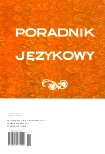METODA ANALIZY GNIAZDOWEJ W BADANIACH SŁOWOTWÓRCZYCH - PRZELOTNY EPIZOD CZY SZANSA BADAWCZA?
The Nest Analysis Method in Word Formation Research - A Temporary Event or a Chance in Research?
Author(s): Mirosław SkarżyńskiSubject(s): Language and Literature Studies
Published by: Dom Wydawniczy ELIPSA
Keywords: słowotwórstwo; gniazdowy słownik współczesnej polszczyzny; Teresa Vogelgesang; słownik gniazdowy; gniazda; gniazdo; semantyka gniazd;
Summary/Abstract: There are two trends in the study of Polish word formation for more than 20 years - the major one focused on the study of relations between the motivated and the motivating word, aimed at interpretation of the formant, its shape and functions and further on at specifying the contents of word formation categories. The latter less popular one modifies descriptions by means of construction of the so-called derivational nests, sets of direct and indirect derivates arranged around the central unmotivated word. The latter trend aims at grasping derivational mechanisms viewed in the category of word formation theme, description of types of transformations, which the theme undergoes due to numerous operations, and finally presentation of the word formation system in contemporary Polish by means of a set of structural models together with the estimated degree of their contribution to the nomination. In its initial part, the article presents the history of the nest method, then the state of works on the final volumes of Słownik gniazd słowotwórczych współczesnego języka ogólnopolskiego (The Dictionary of Word Formation Nests in Contemporary Standard Polish), and on the volume of nests motivated by verbs in particular, whereas in the third part indicates further research directions. According to the author, after the description of the nests 'structures, indication of the derivational models' sets initiated by lexemes of different parts of speech, and specifying central and peripheral areas of word formation system of contemporary Polish, it is necessary to switch into the nest research which would allow to discover the role of semantic factors determining derivational activeness of particular classes of central words, to describe how the notion included in the central word of the nest is modified in consecutive derivates. Eventually, the author suggests application of some ideas from cognitive linguistics, e.g. cognitive metaphor or the notion of scene and profile making. It might lead to a new view on the so-called onomasiological derivates as opposed to the socalled semantic derivates. Moreover, it would allow to build a general model of nomination, integrating semantic and morphological derivation. He also indicates advantages the research of word formation nests may bring to lexicography, like the possibility of using derivational information to estimate borders between homonymity and polysemy or verifying correctness in division of meanings and defining them in dictionaries.
Journal: Poradnik Językowy
- Issue Year: 2004
- Issue No: 02
- Page Range: 81-90
- Page Count: 10
- Language: Polish
- Content File-PDF

